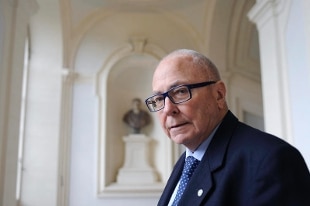Mario Torelli (Contrast)
Share
15 September 2020Archaeologist Mario Torelli, one of the greatest Etruscan scholars, author of important discoveries (such as Gravisca, port of Tarquinia) and fundamental research on ancient Rome, died today at the age of 83. The announcement of the disappearance was given by the General Management of the Mibact Museums, which recalls that Professor Torelli "for some time and in the last period was working, as curator, on the project of a large exhibition on Pompeii and Rome, which he would soon be inaugurating in the seats of Pompeii and the Colosseum, whose institutions are now run by two of his students and where several of his former students work ".
Torelli was professor of Archeology and History of Greek and Roman Art at the Universities of Cagliari and Perugia; since 2010 he was at rest. He was a member of the Accademia Nazionale dei Lincei, a national academic of the Academia Europæa, an ordinary member of the National Institute of Etruscan and Italic Studies in Florence, an academic member of the Sepolti di Volterra, an honorary academic of the Pietro Vannucci Academy of Perugia, a member correspondent of the Academy of Sciences of Turin, of the Deutsches Archäologisches Institut and of the Accademia Nazionale dei Lincei as well as Honorary Member of the British School at Rome and of the American Institute of Archeology. In addition to numerous other awards, he was the winner of the Balzan Prize for Archeology (2014).
Torelli was a member of the international scientific committee of the '' Revue archéologique '', Paris and of the '' Archivo Español de Arqueología '', Madrid, a member of the international team of the '' Thesaurus rituum et cultus antiquorum '' (Basel), he directed since 1992 also the antiques magazine '' Ostraka '' (Naples).
Born in Rome on 12 May 1937, graduated in Literature (classical address) at the University of Rome in 1960, Torelli was assistant in the "Center for Antiquities and the History of Art of the Near East" (1960-1962) ; after winning a regular competition in 1963, from 1964 to 1969 he was an archaeologist inspector at the Superintendence of Antiquities of Southern Etruria. In 1969 he was appointed aggregate professor of Archeology and History of Greek and Roman Art at the University of Cagliari, where he became extraordinary professor in 1973.
In 1975 he was called to the University of Perugia, first as extraordinary professor of Archeology and History of Art Greek and Roman, and since 1976 as full professor; from 1976 to 1987 he directed the Institute of Archeology and from 1994 to 1997 the Institute of Comparative Studies on Ancient Societies. Also at the University of Perugia he was coordinator of the Section for Comparative Studies on Ancient Societies of the Departments of Historical-Artistic Studies and `` Man and Territory '' from 1999 to 2010 and president of the Center of Excellence for the Diagnostics of Cultural Heritage granted on a project signed by the Ministry of Education, University and Research.
Torelli participated in excavations in the Villa di Nerone in Subiaco (1957), in the Roman city of Trebula Mutuesca - today Monteleone Sabino - (1958 and 1959), in the Nubian cities of Sabagura and Ikhmindi (1960) and in the Villanovan necropolis of the Quattro Fontanili in Veii (1961). He directed the excavations of the Etruscan sanctuary of Minerva in Santa Marinella (1964-1966), the Etruscan sanctuary of Porta Cerere di Veio (1966-1969), the Greek sanctuary of Gravisca, the ancient port of Tarquinia (1969-1979 and 1994 -2010), the extra-urban sanctuary of Aphrodite in Paestum (1982-1985), the sanctuary of Demeter and the agora of Heraclea Lucana (1985-1991) near Policoro.
Torelli was Visiting Professor at the Universities of Colorado (1974), Michigan (1978), California Irvine (1979), Sorbonne (1985), École Normale Supérieure (1985), Collège de France (1986), University of Alberta (1986), Oxford (1988) and Bristol (1993); he was a member of the Institute for Advanced Study (1982) and Getty Scholar at the Getty Center for the History of Art and the Humanities at Santa Monica (1990-1991); he has lectured at numerous universities and research institutes in Australia, Bulgaria, Canada, Czechoslovakia, Denmark, Finland, France, Germany, England, Italy, Romania, Spain, United States of America, Sweden and Switzerland, and received his degree honoris causa from the University of Tübingen, Germany, and the University of Jaén, Spain.
Torelli coordinated the planning of the nine exhibitions of the Tuscany Region on the occasion of the '' Year of the Etruscans '' in 1985; coordinated the scientific planning of the exhibition Gli Etruschi held at Palazzo Grassi in Venice from 26 November 2000 to 1 July 2001; he conceived and directed the scientific installation of the '' Etruscan and Roman city of Cortona '' section of the Museum of the Academy and of the Etruscan and Roman city of Cortona (1990-2007); he was responsible for the scientific design of the Etruscan Exhibition. The ancient metropolis of Lazio, held at the Palazzo delle Esposizioni in Rome, from 20 October 2008 to 6 January 2009; he was scientific manager of the design and installation of the Museum of the Etruscan Academy and of the Roman Etruscan City (1999-2005).
He is the author of 27 scientific books and over 400 articles in scientific journals and author of many scientific articles for newspapers and periodicals, including '' Il Messaggero '' in Rome, '' La Stampa '' in Turin (2000-2001) and ' 'The Republic''.

